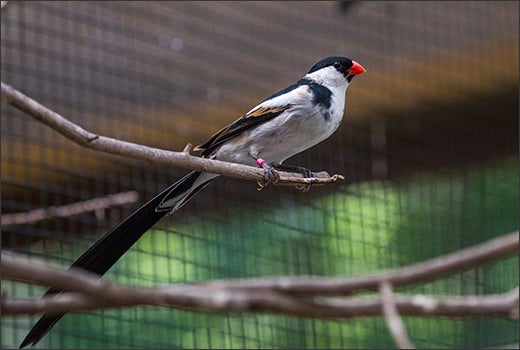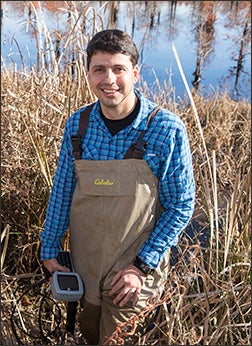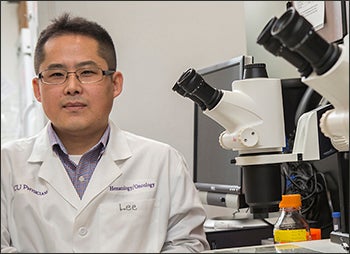DISCOVERY DOLLARS
Major grants push researchers ahead
When the little pin-tailed whydah chirps and flaps its wings in Africa, not much happens in the rest of the world. But what the bird might teach scientists about brain development could have a global impact.
That’s what East Carolina University biologist Chris Balakrishnan and colleagues are looking at, thanks to a National Science Foundation grant of $390,000.

A whydah bird is shown at Sylvan Heights Bird Park. (Photo by Katie Gipple Lubbock)
The whydah is one of about 100 species of birds known as “brood parasites.” That is, they lay their eggs in the nests of other birds and leave their young for those birds to hatch and raise.
What does that have to do with brain development? Though the young whydahs have no contact with their own kind, they nevertheless learn to sing the whydah song and eventually mate with other whydahs. Most birds learn these things from their parents.
“How do these birds learn what they are? How do they not get confused?” Balakrishnan asks. “We’re trying to understand that. What’s different about these birds that aren’t exposed to their parents?”
The findings could give insights into the science of neuroplasticity. That’s the changes in neural pathways and synapses due to shifts in behavior, environment, neural processes, thinking and emotions – as well as changes resulting from injury. The concept has replaced the notion the brain is a physiologically static organ and explores how – and in which ways – the brain changes during a lifetime.
Balakrishnan is one of several young faculty members at ECU who have recently received major research grants. According to Michael Van Scott, interim associate vice chancellor for research and graduate studies, when faculty members receive external funding, it’s a validation of their credentials and ideas by experts in the field and the funding agencies.
“To receive major federal funding means that the faculty member is deemed to be at the top of their field and their work addresses significant problems in society,” Van Scott said. “Accordingly, these awards are prestigious for the institution as well as the individual faculty member.”

Michael Van Scott
The fact that they are faculty members who are relatively recent graduates of their respective doctoral and post-doctoral programs and have joined ECU in the past decade signifies the strength of the university’s efforts to get new faculty members’ research programs up and running.
According to Van Scott, ECU invests $3 million to $5 million each year toward that end. The university also invests approximately $300,000 to $500,000 each year to support new investigative teams with ideas for projects that can be competitive for extramural funding and to provide time for faculty members to write competitive grant proposals. When faculty members receive extramural funding, ECU returns a portion of the indirect costs recovered from the grants to the faculty and units where the research was conducted.
Balakrishnan’s study, “Collaborative Research: Mechanisms of Behavioral Innovation in Brood Parasitic Birds,” is a project with scientists at Hunter College in New York. He submitted the grant proposal two years ago, learned it had been approved in the spring and just received the funding this month.
Working with him at ECU are post-doctoral biologist Matt Louder and master’s student Dustin Foote. The whydahs are housed at Sylvan Heights Bird Park in Scotland Neck.
Only about 5 percent of grant proposals are funded, Balakrishnan said.
“I’ve been trying all different ideas,” he said. “This is my first individual grant success. In terms of getting my individual research going, this is a vital step.”

Marcelo Ardon
Another ECU biologist who has received a significant federal grant is Marcelo Ardon. In the spring, he received an NSF CAREER award of $635,000 for his study of ecosystem recovery in coastal wetlands under a changing climate.
CAREER Awards are the NSF’s most prestigious awards to junior faculty “who exemplify the role of teacher-scholars through outstanding research, excellent education and the integration of education and research within the context of the mission of their organizations,” according to the organization’s website.
This spring, he also received one of the first Thomas Harriot College of Arts and Sciences Dean’s Early Career Awards recognizing exceptional performance by tenure-track professors.
Ardon completed his doctorate in 2006 and joined the ECU faculty in 2011. His research focuses on human impacts of the ecology of wetlands and streams.
Junior faculty members in the Health Sciences Division have also landed significant federal grants within the past year.
Jamie Perry, an assistant professor of communication sciences and disorders in the College of Allied Health Sciences, has received a $409,170 grant from the National Institutes of Health for a study related to velopharyngeal function, or how the structures of the mouth affect speech.

Myon-Hee Lee
Myon-Hee Lee, an assistant professor of medicine at the Brody School of Medicine, has received a three-year, $367,275 NIH grant for his study of germline stem cells in a species of nematode. Germline stem cells are able to self-renew and generate a continuous supply of gametes through differentiation, or changing from one cell type to another. Lee wants to understand how these germlines are created and regulated.
Another Brody faculty member, Joe McClung, an assistant professor of physiology, has received grants from the NIH/National Heart, Lung and Blood Institute to study aspects of peripheral artery disease. The major ones are a three-year, $532,580 “Pathway to Independence Award” to study a type of cell involved in cardiovascular disease and a five-year, $1.25 million grant looking at an element of limb vasculature, such as occurs in peripheral arterial disease.
Carol A. Witczak, an assistant professor of kinesiology in the College of Health and Human Performance and biochemistry and physiology in the medical school, has received a $1.6 million NIH grant to study skeletal muscle glucose metabolism, work that could point the way to new diabetes treatments. That follows a 2010 NIH award for $751,000 to study skeletal muscle growth and protein synthesis.
She joined ECU in 2010.

Raz Shaikh, left, and Dave Brown
Raz Shaikh, an associate professor of biochemistry, has received a five-year, $1.6 million NIH grant to study how omega-3 fatty acids can help suppress inflammation and boost immunity to viral infection. Shaikh has also received NIH funding in collaboration with physiologist Dave Brown.
Brown, an associate professor, has received three grants totaling $1.7 million from the NIH/NHLBI to study various components of mitochondrial function related to cardiac ischemia reperfusion.
Brown and Shaikh have also attracted industry funding for their research.
Many of these health sciences grants are collaborative with other researchers working on the fourth floor of the East Carolina Heart Institute at ECU.
“The tally of new money coming in from Drs. McClung, Shaikh and I is in the neighborhood of $5 million,” Brown said.
“We take a lot of pride that ECHI fourth floor is responsible for that, as our new institute model is a bit of an experiment.”